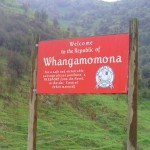
Since 1989, the town of Whangamomona has been an independent republic.
According to legend, back in 1989 the New Zealand government decided to move Whangamomona from one administrative region to another. This proved very disturbing for the residents since they would then be represented in the rugby leagues by the regional team that had long been an enemy. Loyal to death, no Kiwi would so blithely switch allegiance; you can see on the walls of its only bar dozens of team photos and rugby tributes for the players they have cheered over the years. So the townsfolk declared themselves an independent republic, free to choose sides.
The rugby turns out to be the most serious part of this secession from New Zealand, for when the first President of the Republic left office, the voters elected Billy Gumboot the Goat. Rumors of election fraud arose as Billy was accused of eating the challengers’ paper ballots, but he served for 18 months until he died in office. Later, Tai the poodle won the Presidency, but resigned from office after surviving an assassination attempt by unknown parties. Regrettably, a human being currently serves as President.
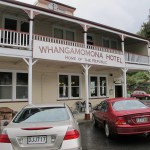
Whangamomona is tiny: you enter the Republic from New Zealand on one side of town and, if you don’t stop for long, depart a few minutes later back to New Zealand on the other side of town. Unsurprisingly, it’s still very Kiwi. The 30 townsfolk are subject to the same licensing and taxing rules of the surrounding country. It’s even an NZ Historic Place due to its role as a service center for early settlers. Now its lone commercial enterprise, the stately Whangamomona Hotel, serves visitors and locals alike from morning light till 3am (passports available on request). It’s even for sale, as we write, if you want a touch of history as an asset.
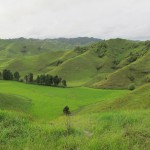
The road through the Republic is part of the Forgotten World Highway. That road winds northeasterly through more than 150 kilometers of conical hills and twisting valleys, starting at Stratford on the edge of imposing Mount Taranaki. You pass through a dizzying landscape, a mix of dairy or sheep ranches and extensive natural preserves, including a vertiginous 11 kilometer long gorge.
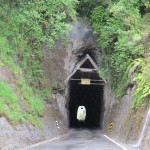
The highway’s name appears to come from a sense that you have gone back in time to a relatively unspoiled, pastoral New Zealand. Though the terrain is highly cultivated and farmed, it feels primordial, volcanic in nature as well. To us, the name also recalled the struggles of now forgotten settlers from fifty to a hundred years ago, those who tried to turn this difficult landscape into productive farms, and often failed. The few old buildings in the emptied towns and the one lane tunnels once carved optimistically out of the rocky hillocks testify to that lost time.
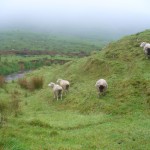
For us, the most impressive feature was the remote Mt. Damper Falls, the second tallest waterfall (at 85 meters, or 280 feet) among the myriad falls in New Zealand.
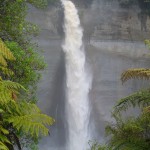
After driving 15 kilometers down a side road, you take a short trail, first through farmland tended by a host of skittish sheep, then along a forest trail to viewing stations across from the big falls and several other smaller ones emptying into the same deep channel.
The Republic of Whangamomona, at the center of all this, may be nominally independent, but the people are pure Kiwi in character, as we observed from two separate incidents during the day of our visit.
Helping Hands
In that picturesque gorge about a half hour away from town, a 20-something visitor from Maryland stopped at the side of the slick, hard-packed dirt road to take a photo of a slender waterfall across the gap. Too close to the ditch running alongside the road, he found, as suddenly his minivan keeled over into the ditch at a 45 degree angle. After a while, a couple of local ranchers came by; one stayed with the driver in the cold drizzling rain and the other took the passenger back to Whangamomona to get help. No cell service, of course. The hotel’s owner rang up a couple of locals, who drove their trucks to the gorge to give a hand. Latching ropes and hooks to the back of the minivan, they hauled it backwards and eventually out of the ditch in about a half hour. Staying just long enough for a few thank-yous and a call for celebratory beers, they headed back to town, over an hour and a half after being summoned, as the Maryland driver carefully, very carefully, moved on.
Street Smarts
There are several signs at either end of the Forgotten Highway alerting you that no filling stations are available along the way. All the maps say the same thing. But there at the Whangamomona hotel bar, 70 kilometers from a gas station, one of a trio of young men in another minivan asked the bartender where they could buy some fuel…as they were nearly out. The bartender looked at them, as she must have looked at many other hapless travelers, and told them no gas was available “and didn’t you see the sign at the start of the highway?” The one she was addressing seemed a bit obtuse, noting that the driver didn’t want to fill up where the gas was expensive. She replied peevishly, “Well, now you get to use some pretty cheap fuel if you need to walk out of here.”
Undaunted, the trio quizzed locals nearby and eventually found a woman who said she could sell them some gas. For reasons only they could know, they said something that got her a bit irritated too, so she offered them 5 liters at $4 per litre, double the typical price at a gas station. They grudgingly agreed, took the 5 liters and drove off. Wait, we said, when we heard this part of the story…at maybe 10 kilometers per liter, they would get just a bit over half the way back. The grinning bartender agreed, explaining that the local woman and a few friends packed up some more gas and soon set out after them. When the trio ran out of fuel again, she intended to sell them the rest for, well, whatever she wanted.
—–
Kiwi all the way. They’ll do whatever they can to help you, no matter how stupid you’ve been to need help, but they know how to teach you a good lesson when you deserve one.
(For more pictures from New Zealand, CLICK HERE to view the slideshow at the end of the New Zealand itinerary page.)


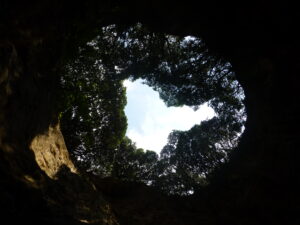
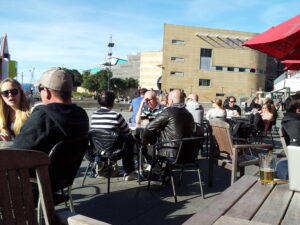
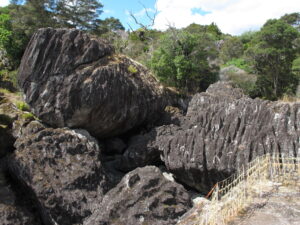
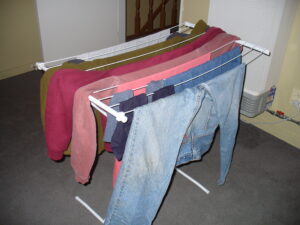
great story! …so where were the three stooges from?
Their accent suggested Dutch or German, perhaps, and their faces were consistent as was their somewhat formal English. It was their age and backpacker look – with the cost cutting mentality that goes with it – that was most obvious.